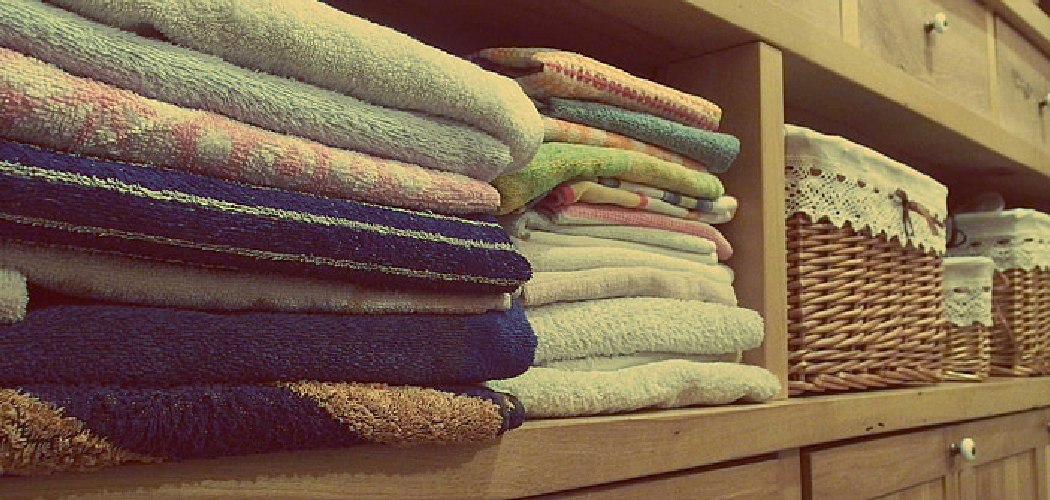Finding a place to store linens without a closet can seem like a daunting task for many homeowners and renters alike. This common challenge arises in small apartments, older homes, or any living situation where closet space is minimal or non-existent. The absence of a designated storage area for linens necessitates creative solutions to keep bedsheets, towels, tablecloths, and blankets neatly organized and easily accessible.
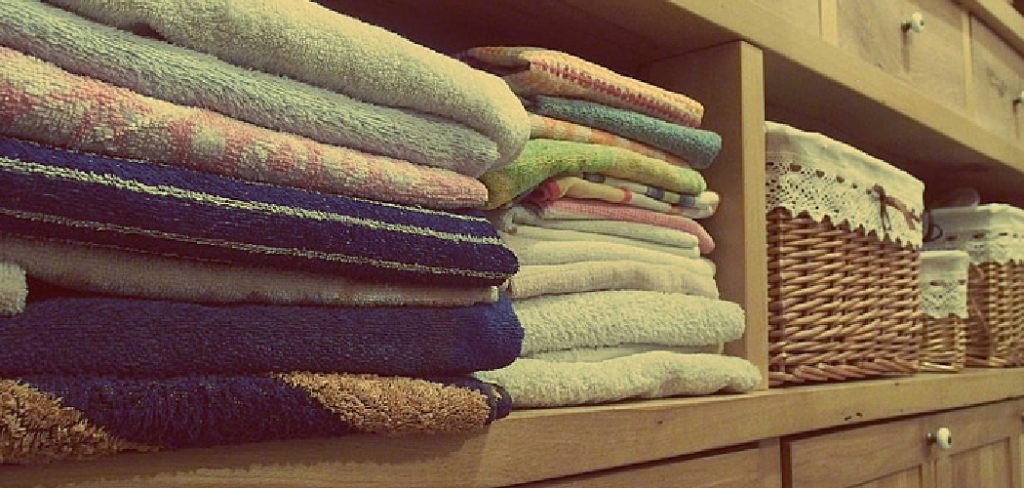
Efficient storage solutions are not just about finding a place for your linens; they play a crucial role in maximizing the available space, reducing clutter, and enhancing the aesthetics of your living spaces. Organized linen storage ensures that your home remains tidy and functional, providing peace of mind and convenience.
This guide on how to store linens without a closet will explore various innovative and practical strategies to overcome the challenge of limited storage space. By implementing these solutions, you can enjoy the benefits of an organized home, where every linen has its place, contributing to your living environment’s overall comfort and efficiency.
Assessing Linen Inventory and Space
Before you can begin to implement any storage solutions, it’s essential to assess what you’re working with both in terms of linens and available space. Start by taking inventory of your linens. Lay everything out and sort them by category: sheets, towels, tablecloths, and blankets.
This process helps determine what you need to store and identify items you may no longer use or need. By understanding your exact storage requirements, you can avoid allocating precious space to linens that are past their prime or seldom used.
Next, survey your home for potential storage areas. Look beyond traditional spaces; think about under-utilized areas such as under the bed, over doors, or even corners of rooms that could accommodate vertical storage options. This step is about identifying all possible storage spaces, including furniture that could double as storage, such as ottomans with compartments or drawers under beds.
The final step involves identifying creative storage solutions that leverage the available space and accommodate your linen usage patterns. For example, if you frequently use certain linens, you’ll want them stored more accessible.
Conversely, seasonal or special occasion linens can be stored in harder-to-reach spots since you won’t need to access them as often. This phase is about matching your storage solutions to your real-life usage and space availability, ensuring that your linens are stored in a way that is both practical and efficient.

Decluttering and Organizing
A. Sorting and Purging Unused or Excess Linens to Streamline Storage
One foundational step in maximizing storage for linens, especially when working without a closet, involves decluttering your linen collection. Begin by sorting through all linens and assessing each item’s condition and frequency of use. It’s essential to be decisive; remove any linens that are worn out, rarely used, or no longer fit your current needs.
This might include old bed sheets that no longer match your decor, excess towels taking up valuable space, or specialty tablecloths that haven’t seen the light of day in years. Purging unused or excess linens not only streamlines your storage but also reduces clutter, making it easier to organize what you decide to keep.
B. Categorizing Linens by Type (e.g., Sheets, Towels, Blankets) for Efficient Organization
After decluttering, the next step is organizing your linens by category. This methodical approach aids in creating an efficient storage system where items are grouped by their type, such as sheets with sheets, towels with towels, and so on.
By categorizing linens, you enhance the visibility and accessibility of each item, making it simpler to find what you need without disturbing the entire storage setup. This organization principle applies whether storing linens in furniture with hidden compartments, using vertical space, or employing under-bed storage solutions.
C. Implementing Storage Solutions to Maximize Accessibility and Visibility of Linens
With purged and categorized linens, implementing tailored storage solutions becomes a more streamlined process. For instance, frequently used items like daily towels or bed sheets might be stored in easily accessible locations, such as in a decorative chest in the bedroom or a neatly organized shelf in the bathroom.

Conversely, seasonal or infrequently used items, such as heavy blankets or special occasion tablecloths, can be stored in under-bed containers or high closet shelves. Throughout this process, visibility and accessibility are key. Opt for clear storage containers or label boxes and shelves clearly, ensuring every linen has a designated spot that’s both practical for use and efficient in maintaining organization.
Gathering Necessary Supplies
Once you’ve decluttered your linens and planned out your storage strategy, the next step involves gathering all the necessary supplies to execute your plan effectively. For linen storage without a closet, recommended storage containers include vacuum seal bags, which can drastically reduce the volume of bulky items like comforters and winter blankets, and clear plastic bins, which protect linens from dust and pests while making it easy to see what’s inside. Fabric storage boxes are also a great option, especially for storing in open spaces, as they offer a more aesthetically pleasing look.
Additional supplies might include acid-free tissue paper or cotton bags for wrapping special linens or seasonal items that won’t be used for an extended period. This extra layer of protection helps prevent yellowing and keeps items fresh. It’s also beneficial to have a labeling system in place, whether that means using a label maker or simply sticking handwritten labels on containers. This step ensures that you can easily identify and retrieve what you need without unnecessary searching.
Finally, it’s important to ensure that your storage space is maximized for both capacity and accessibility. This might mean installing shelving units or under-bed drawer systems to make the most of underutilized space. Proper planning in this phase guarantees that your linens are not only well-organized but also accessible for easy retrieval, maintaining the efficiency and functionality of your living space.

Utilizing Furniture for Storage
Innovative use of furniture can significantly enhance linen storage in homes lacking closet space. By strategically selecting pieces that serve dual purposes, you maintain a decluttered, organized home while ensuring linens are stored properly and accessible when needed.
A. Incorporating Chests, Trunks, or Ottomans with Storage Compartments for Linens
Chests, trunks, and ottomans are stylish pieces of furniture that add character to any room. They can also serve as hidden storage gems for linens. These furniture pieces are perfect for storing extra sheets, blankets, and towels, keeping them out of sight yet easily accessible. Placing a storage ottoman at the foot of the bed or using a decorative chest in the living area can seamlessly integrate linen storage into your home decor.
B. Choosing Bed Frames or Headboards with Built-in Storage for Linens
Selecting bed frames or headboards with built-in storage compartments can drastically increase your storage options without taking up extra space. These beds often feature drawers underneath or shelving within the headboard, ideal for storing bed linens, pillows, and seasonal bedding. This solution not only keeps linens dust-free but also maximizes the unused space beneath or behind the bed.
C. Repurposing Bookshelves or Cabinets for Linen Storage in Living Areas or Bedrooms
Bookshelves and cabinets traditionally used for books or display items can be creatively repurposed for linen storage. Adjustable shelves in bookcases can accommodate folded linens, while cabinets can hide away less frequently used items like special occasion tablecloths or extra pillows. This approach allows for the efficient use of vertical space in living areas and bedrooms, integrating linen storage into the fabric of the room’s design.
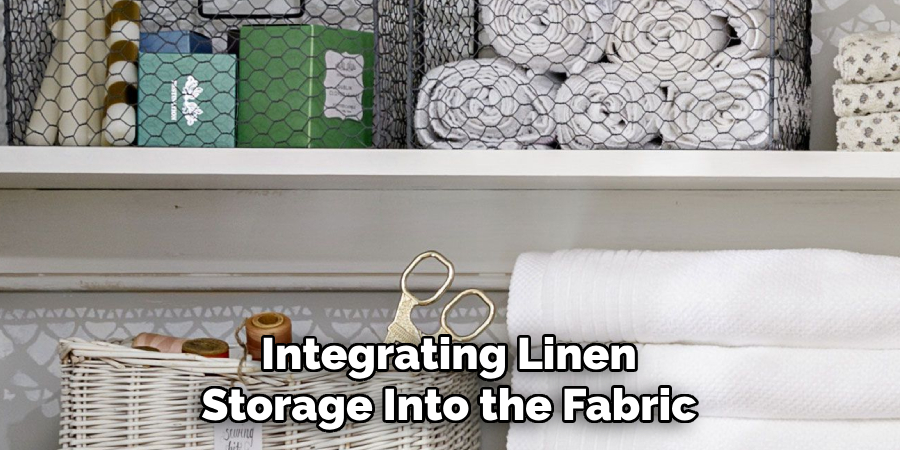
How to Store Linens without A Closet: Maximizing Closet Space
Even in homes with limited closet space, innovative ways exist to maximize the space available and ensure that every inch is used efficiently for linen storage.
A. Installing Freestanding or Wall-Mounted Shelving Units in Unused Closet Space
One of the simplest ways to increase storage space in a closet is by installing freestanding or wall-mounted shelving units. These can be placed at the top of the closet for rarely used items or along the sides to make use of awkward spaces that are otherwise wasted. Shelving units allow for the orderly stacking of linens, making it easy to organize by type or usage frequency and ensuring that everything is visible and accessible.
B. Utilizing Over-the-Door Organizers or Hooks for Hanging Linens Inside Closet Doors
Over-the-door organizers and hooks offer a clever solution to the underutilized space on the inside of closet doors. They can be used to hang towels and robes or even to organize and store smaller linen items such as tablecloths and napkins in pockets. This not only helps in keeping these items wrinkle-free but also contributes to decluttering shelves and drawers within the closet.
C. Adding Drawer Organizers or Dividers to Optimize Closet Storage for Linens
For closets that include drawers, utilizing drawer organizers or dividers can significantly enhance the organization of smaller linen items like hand towels, washcloths, and pillowcases. These tools allow for categorizing the space effectively, making it easier to find what you need without rummaging through piles. Additionally, they help maintain the integrity of the linens by preventing unnecessary folding and creasing.
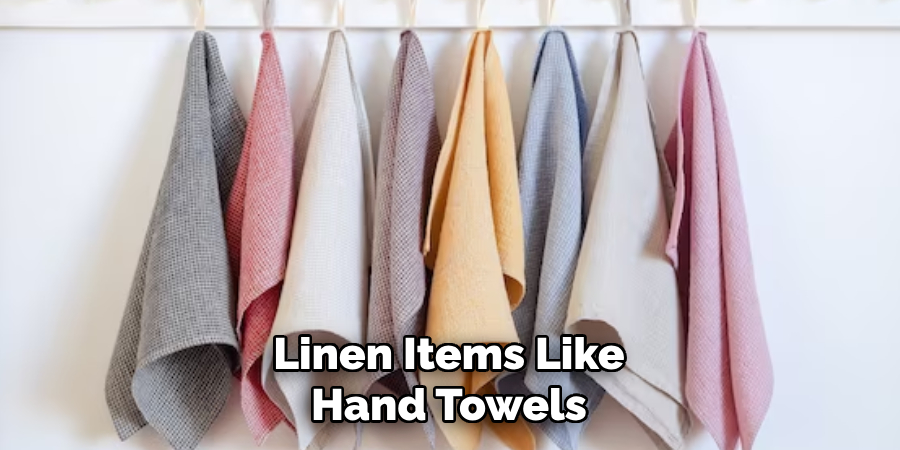
How to Store Linens without A Closet: Creating Dedicated Linen Storage Areas
Maximizing your home’s storage capabilities often requires creativity, especially when it comes to organizing linens in spaces that might not be immediately thought of as storage-friendly. By designating specific areas and employing innovative storage solutions, you can immensely improve both the accessibility and longevity of your linens. Here are some effective strategies to consider:
A. Designating Cabinets or Drawers in the Bathroom or Kitchen for Linen Storage
Utilizing cabinets or drawers in the bathroom or kitchen specifically for linens can streamline your organization and make retrieval a breeze. In the bathroom, dedicate a cabinet or a few drawers solely for storing towels, washcloths, and bathmats, ensuring they’re easily accessible right where you need them.
Similarly, in the kitchen, allocate space for dish towels, napkins, and tablecloths. This dedicated space will not only keep your linens neatly organized but also prevent them from becoming mixed up with other household items.
B. Installing Floating Shelves or Display Racks for Storing Folded Linens in Living Areas
Floating shelves or display racks in living areas can serve as both a decorative and functional storage solution for linens. You can turn them into a part of your home’s decor by neatly folding and stacking linens, such as throws and spare blankets. This approach not only makes efficient use of vertical space but also keeps these items within easy reach, adding a cozy and welcoming touch to any room.
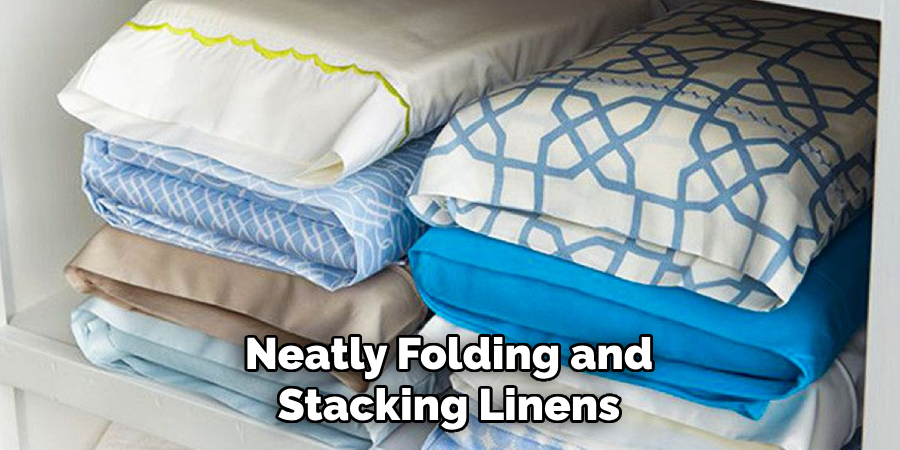
C. Using Under-Bed Storage Containers or Bags for Seasonal or Infrequently Used Linens
For seasonal or infrequently used linens, such as heavy comforters or special occasion table linens, under-bed storage containers or bags offer an out-of-sight yet accessible solution. These storage options make perfect use of the often-underutilized space beneath beds, keeping these items dust-free and protected until they’re needed.
Opt for clear containers or bags with a viewing window to easily identify the contents without having to open them, ensuring that swapping out linens with the changing seasons is as efficient as possible.
Space-Saving Solutions for Small Spaces
In homes where every square inch counts, adopting space-saving solutions for linens can significantly affect how organized and airy the space feels. Among the most effective strategies are:
- Rolling or Folding Linens Neatly to Save Space in Storage Containers or Bags: Rolling towels, blankets, and even fitted sheets can drastically reduce the space they occupy. This method is not only efficient for drawer and shelf storage but also ideal for packing linens into storage containers or bags, allowing for a tidy and compact arrangement.
- Vacuum-Sealing Bulky or Seasonal Linens to Reduce Size and Maximize Storage Capacity: Vacuum-sealing provides an excellent solution for bulky items like comforters, winter bedding, and spare pillows. By removing the air, these items significantly decrease in size, freeing up valuable closet or under-bed storage space. This method also offers the added benefit of protecting the linens from moisture, dust, and pests.
- Utilizing Vertical Space with Wall-Mounted Shelves or Hooks for Hanging Linens: When floor space is limited, looking up can offer new storage opportunities. Installing wall-mounted shelves or hooks provides a platform for organizing and hanging linens, such as guest towels or frequently used blankets. This approach not only saves space but also keeps linens within easy reach, enhancing the functionality of the living space.
Regular Maintenance and Rotation
Maintaining the quality and extending the lifespan of your linens involves more than just proper storage; it requires a conscientious effort in their regular care and rotation. This practice not only preserves the fabric’s integrity but also ensures that your home always has fresh, ready-to-use linens. Here are key strategies to consider:

A. Implementing Regular Linen Rotation to Prevent Damage and Ensure Freshness
Regular rotation of linens is essential to prevent wear and tear on the most frequently used items. This involves moving older linens to the front for use and placing freshly laundered ones at the back of the closet or drawer. Such rotation ensures even usage and helps maintain the freshness of all linens, as they are not left sitting unused for extended periods.
B. Washing and Storing Linens Properly to Maintain Quality and Longevity
Washing linens according to their specific care instructions is pivotal in preserving their quality. Use gentle detergents and avoid harsh chemicals that can degrade fabric fibers over time. After laundering, ensure linens are thoroughly dried before storing to prevent mold and mildew growth. Additionally, storing linens in a cool, dry place away from direct sunlight can help prevent fading and fiber degradation.
C. Conducting Seasonal Inventory Checks and Purges to Keep Linen Storage Organized
At least twice a year, preferably during seasonal changes, conduct an inventory check of your linens. Assess the condition of each item, identifying those that are worn out or no longer used for donation or repurposing.
This practice not only keeps your linen collection refreshed but also maximizes storage efficiency by eliminating clutter. Seasonal purges paired with inventory checks ensure that your linen storage remains organized and functional, accommodating your changing needs throughout the year.
Labeling and Categorizing
Proper labeling and categorizing are vital components of an efficient linen storage system. Implementing these strategies not only streamlines the retrieval process but also ensures that every item is stored in its designated place, reducing clutter and maximizing organizational efficiency.
A. Using Clear Labels or Tags to Identify Linen Contents and Storage Locations
Employing clear, descriptive labels or tags on shelves, bins, and containers significantly simplifies the process of finding specific linens. Whether it’s labeling shelves in the linen closet or attaching tags to storage bins, these markers should clearly indicate the contents or category of linens they house.
For an even more organized approach, consider using color-coded labels to quickly distinguish between different types of linens, such as bedding, table linens, and towels.
B. Grouping Similar Linens Together for Easy Retrieval and Organization
Organizing linens by grouping similar items together not only saves time during retrieval but also maintains a tidy storage space. Store items like bed sheets, pillowcases, and duvet covers in one designated area, while towels, washcloths, and bathmats occupy another. This categorization allows for quick access and simplifies the process of changing linens, ensuring a seamless transition between sets.

C. Updating Labels or Inventory Lists as Linen Inventory Changes or Evolves
Maintaining an accurate and up-to-date inventory list or label system is crucial as your linen collection changes. Regularly updating labels or inventory lists will keep your storage system functional and efficient, whether it’s due to acquiring new linens, repurposing old ones, or seasonal changes necessitating different storage strategies.
This ongoing process ensures that every item remains in its rightful place and that the contents of storage areas are always clearly identified, streamlining upkeep and access.
Conclusion
In summary, this guide has explored various strategies and techniques on how to store linens without a closet, emphasizing the importance of creativity and adaptability in maximizing available space.
From folding techniques that save space to innovative uses of furniture and vertical storage solutions, we’ve seen that successful linen storage and organization are achievable with a bit of ingenuity. Key factors for success include regular maintenance and rotation of linens, proper labeling and categorization, and the importance of conducting seasonal inventory checks.
The guide underscores the significance of resourcefulness in overcoming the challenge of limited storage space. By employing these methods, readers can transform their linen storage from cluttered and chaotic to streamlined and efficient. Whether you’re living in a small space without a dedicated linen closet or simply seeking to optimize your existing storage, this guide provides a comprehensive toolkit for keeping your linens organized and readily accessible.
We encourage readers to implement these strategies and to view the constraints of not having a linen closet not as limitations but as opportunities to innovate and refine their home organization skills. With the right approach, learning how to store linens without a closet can lead to a more organized home and a greater appreciation for the linens that bring comfort and beauty into our living spaces.

